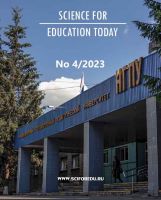Исследование динамики взаимосвязи стилей и типов мышления личности специалистов в условиях профессионального медицинского образования
Studying the dynamics of interrelations between styles and types of thinking of professionals in the context of higher medical education
Author(s): Lyubov Alekseevna Kramskaya, Yulia Mikhailovna Perevozkina, Yuliya Vladimirovna Poshekhonova, Mergalyas Mergalimovich KashapovSubject(s): Higher Education , Educational Psychology, Cognitive Psychology, Health and medicine and law, Sociology of Education
Published by: Новосибирский государственный педагогический университет
Keywords: Resource approach; Clinical thinking; Thinking style; Type of thinking; Professional medical education; Creativity; Medical students; Attending physicians; Doctors;
Summary/Abstract: Introduction. The relevance of studying professional thinking in the context of higher medical education is determined by theoretical and practical significance of the problem, which has an epistemological, not ontological nature: the formation of doctor’s professional clinical thinking. The article presents the findings of an empirical study of psychological patterns underlying the correlation between styles and types of thinking among medical students, attending physicians, and doctors in academic and professional activities. The purpose of the article is to identify the dynamics of relationships between styles and types of thinking among doctors at different stages of their professional development. Materials and Methods. Stylistic and typological features of doctors’ thinking were established by analyzing acmeological and psychological mechanisms of professionals’ creative thinking in the context of a metacognitive approach. Based on the resource approach to understanding the phenomenon of professional thinking, clinical thinking is considered as the highest cognitive process of searching, detecting and resolving problems, identifying externally unspecified, implicit properties of the cognizable and transformed medical situation. The following methods were used: A.K. Belousova’s ‘Styles of thinking inventory’ and V.A. Ganzen, K.B. Malyshev, L.V. Oginets’s ‘Method of identifying the type of thinking and the level of creativity’. Results. The authors have revealed the interrelation between styles and types of thinking of medical students, attending physicians and doctors. It was established that the dominant type and style of medical students, attending physicians and doctors’ thinking are the imaginative type of thinking and the practical style of thinking. The authors clarified and described the dynamics of interrelations between thinking styles and types in medical students, attending physicians and doctors. It varies depending on the stage of doctor’s professionalization. The psychological peculiarities of typical and stylistic characteristics of doctor's thinking were revealed. The authors summarized the connection of doctors' creative abilities with leading styles and types of thinking and described the resources of professionalization of clinical thinking. Conclusions. The article presents the understanding of doctor’s professional thinking as a type of thinking, whose laws are based on general laws of thinking, but follow the specifics of medical activities. It is shown that the connections between the styles and types of doctor’s thinking acquire quantitative and qualitative peculiarities at the certain stages of doctor’s professional development.
Journal: Science for Education Today
- Issue Year: 13/2023
- Issue No: 4
- Page Range: 196-217
- Page Count: 22
- Language: Russian

